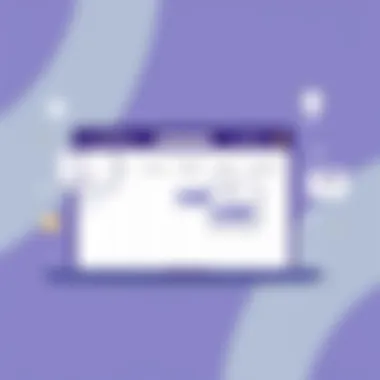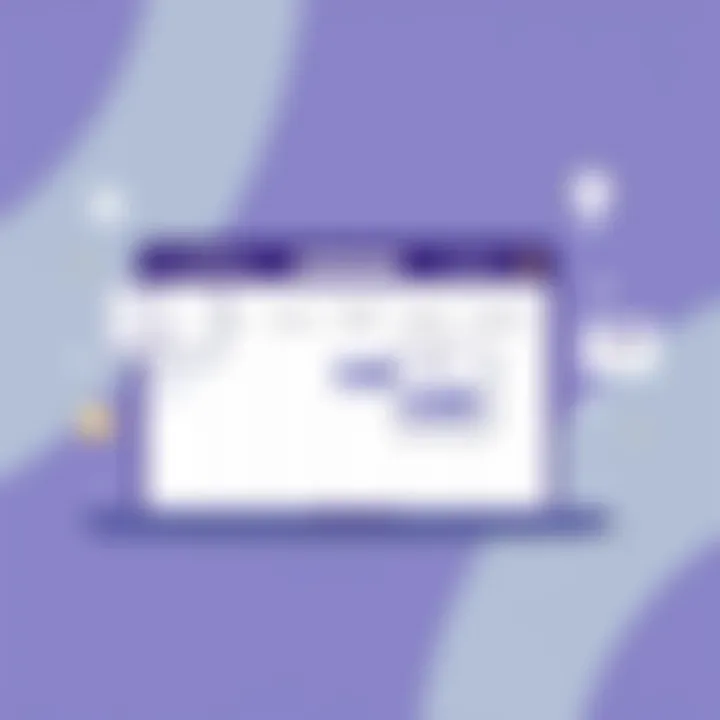Crafting an Effective To-Do List in OneNote


Intro
In today's fast-paced world, a disorganized mind is often a recipe for disaster. The digital realm offers many tools to help us navigate our complex tasks with precision, and Microsoft OneNote stands out among these options. With its ability to blend note-taking with a robust task management framework, OneNote empowers users to create a to-do list that fosters clarity and focus.
Constructing an effective to-do list is not merely about jotting down tasks; it's about creating a structured environment where priorities shine and productivity flourishes. Throughout this article, we will uncover how to utilize OneNote effectively for crafting a comprehensive to-do list. By understanding its core functionalities and exploring ways to adapt it according to growing demands, users can significantly enhance their operational efficiency and organization.
The beauty of OneNote lies in its versatility. Regardless if you're juggling personal errands or managing a professional project, this application can be tailored to fit diverse needs. Let’s delve deeper into its functionality, discussing key features that make it a suitable choice for anyone serious about managing their tasks.
Functionality
Overview of key features
OneNote presents users with several noteworthy features, presenting an all-in-one workspace both organized and accessible. Here’s a glimpse of what OneNote offers:
- Flexible note organization: Users can create multiple notebooks, sections, and pages, allowing for a hierarchy that mimics physical notebooks.
- Tagging system: OneNote’s tagging feature lets users highlight important tasks or notes, making it easier to identify priorities at a glance.
- Integration with other applications: Seamlessly connect OneNote with Microsoft Outlook, which permits direct management of tasks from emails.
- Search functionality: OneNote's powerful search tool allows users to locate information quickly, making task retrieval hassle-free.
These features together form the backbone of a to-do list that isn’t just an afterthought but an integral part of efficient task management.
How well the software meets user needs
The adaptability of OneNote to various user requirements is a significant aspect of its appeal. For professionals, a well-organized to-do list ensures deadlines are met and workflows remain uninterrupted. Here’s how OneNote caters to different users:
- For students: OneNote acts as a dynamic study tool, helping them organize lecture notes alongside to-do lists focusing on assignments and exams.
- For project managers: The ability to collaborate in real time makes OneNote ideal for teams needing effective communication and task allocation.
- For everyday users: Whether grocery shopping or planning events, its user-friendly interface simplifies tracking tasks efficiently.
By addressing diverse user needs, OneNote stands as a flexible tool capable of growing alongside its users, ultimately enhancing overall productivity.
Scalability
Adaptability for growth
As one's tasks evolve, so must the tools employed to manage them. OneNote is not just a static application; it is designed to grow with you. The limitless notebook structure ensures that you can adjust your task organization as your responsibilities increase.
- New sections for new tasks: Easily insert additional sections as projects expand or shrink, maintaining clarity and focus.
- Incorporation of multimedia: In today's digital age, adding videos, audio notes, or images can further enrich tasks, making it easier to digest information.
Options for additional features or modules
While OneNote itself is a powerful singular tool, it also welcomes integrations with other Microsoft products and various third-party applications. Custom templates can be created, which enhance the overall functionality of your to-do lists.
- Microsoft To Do integration: Sync tasks directly from OneNote to Microsoft To Do for an added layer of organization.
- Automation through Power Automate: Set up workflows to transform how you manage tasks by automatically updating or creating notes based on triggers.
With these options, OneNote doesn’t just serve existing needs but also prepares users for whatever may come next, ensuring it remains a relevant component in any productivity toolkit.
An effective to-do list in OneNote not only tracks tasks but transforms how users approach their daily responsibilities, setting the stage for greater accomplishment.
By focusing on both functionality and scalability, OneNote equips users with the tools and flexibility necessary to maintain a high level of productivity. As we move further, we’ll explore actionable tips and strategies to maximize OneNote's capabilities, offering a clear path for users seeking streamlined task management.
Prologue to OneNote as a Task Management Tool
In today's fast-paced world, keeping track of tasks can seem like trying to catch smoke with your bare hands. No wonder so many individuals turn to tech solutions to streamline their organization. OneNote, Microsoft's versatile note-taking application, stands out in this regard. It’s packed with features that can transform the way you manage tasks and projects. This section digs into the importance of OneNote as a task management tool, shedding light on what makes it a go-to choice for many.
Understanding OneNote’s Versatility
OneNote isn’t just a digital notebook. It serves as a flexible workspace where ideas and tasks can coexist symbiotically. The platform allows users to create notebooks, sections, and pages, facilitating a natural flow of information that mirrors how many organize their thoughts. For instance, a graphic designer might maintain separate notebooks for project ideas, client lists, and deadlines, with sections dedicated to different tasks within those projects. This level of organization isn’t just neat; it enhances productivity by providing a clear path to every bit of information.
Additionally, OneNote integrates seamlessly with other Microsoft Office applications. Whether you’re pulling data from Excel spreadsheets or embedding presentations from PowerPoint, the integration paves the way for a comprehensive task management experience that’s hard to beat.
The Relevance of To-Do Lists
The age-old to-do list has transcended the written page to evolve into a pivotal element of digital productivity. At its core, it’s all about prioritization and accountability. A solid to-do list helps break down complex projects into manageable tasks, allowing you to tackle daunting ambitions piece by piece. OneNote takes this classic concept several steps further.
- Visual Appeal: Unlike lined sheets of paper, OneNote’s digital format allows you to create visually appealing lists. Use colors, fonts, and even images to categorize and enhance the information.
- Accessibility: With OneNote available on multiple devices, accessing your tasks is as easy as pulling your phone from your pocket. Whether at the office or on the go, your list is just a tap away.
- Collaboration: Several tasks require input from different team members. Sharing a OneNote notebook ensures everyone stays on the same page—literally and figuratively. Task assignments and updates can occur in real-time, boosting overall efficiency.
As we dive into how to set up and design your to-do list in OneNote, keep in mind that the aim is not just to check off tasks but to enable a more structured approach to your daily responsibilities. Embrace the journey of task management, leveraging the power of OneNote to ensure you can grasp those elusive tasks with confidence.
"A well-organized task list is the first step towards effective time management and ultimate productivity."
By exploring OneNote’s capabilities in depth, we can form a blueprint that not only helps you become more organized but also fosters an environment where tasks become stepping stones rather than burdens.
Setting Up OneNote for Task Management
Setting up OneNote effectively for task management is not just about opening the application and jotting things down; it's a delicate dance of organization and personalization. When utilized correctly, OneNote can be transformed into a powerful ally that keeps projects on track and priorities clear. The task management experience starts with the way you structure your Notebooks, Sections, and Pages. This setup creates a solid foundation for a To-Do list that flows with your work style.
A well-organized OneNote means less time hunting for information and more time focused on execution. Think of it as crafting a roadmap for your daily activities, aligning your tasks with your goals seamlessly. By addressing this aspect of OneNote early, you put yourself in a position to capture tasks as they arise, ensuring nothing slips through the cracks.
Creating Your Notebook
The first step in task management within OneNote is creating a dedicated Notebook. Think of a Notebook as the overarching category for your tasks—like the cover of a binder where all things relevant to a project are stored. You might have different Notebooks for separate major projects or areas of life—be it work, personal projects, or even hobbies.
To create a Notebook:
- Open OneNote and go to the Notebooks panel.
- Click on Add Notebook and name it suitably, reflecting its purpose. For example, "Work Projects" or "Home Tasks". The name provides an immediate understanding of its contents.
It's important to keep in mind that a well-structured Notebook not only aids in task management but also enhances your overall productivity. It can help in avoiding that chaotic feeling when tasks pile up and become hard to track.


Structuring Sections and Pages
Once your Notebook is set up, the next logical step is structuring it into Sections and Pages. Consider Sections as the tabs in your binder that separate different subjects or categories. Each Section can house specific areas of focus within your broader project. Within these Sections, you can create Pages that serve as the place for your actual To-Do lists and notes.
For example, if your Notebook is titled "Work Projects," you might create Sections for different projects like "Client A" and "Client B." Each Section can then contain Pages that detail tasks unique to those clients. This setup allows you to manage diverse responsibilities without overwhelming yourself with information.
In organizing your Sections:
- Use meaningful titles that provide clarity at a glance.
- Keep the structure intuitive. Think about how you think and process information
- Consider setting up a top-level section for general or recurrent tasks that apply across multiple projects.
An effective structure will make it a breeze to navigate through your tasks. By diving into OneNote with a solid layout, you're ensuring that your To-Do list is not only functional but also a reflection of your workflow.
Remember, a well-organized Notebook is like a well-organized mind—everything in its place, allowing for clarity and productivity.
Designing Your To-Do List
Creating an effective to-do list is like laying down a roadmap for your day-to-day activities. It allows you to keep your tasks organized and enhances your productivity considerably. A well-designed to-do list transcends mere task tracking; it enables clarity, minimizes overwhelm, and leads to more effective time management. When crafting your to-do list in OneNote, you’re not just jotting down tasks; you’re designing a personal system that works for you and complements your workflow.
The art of designing a to-do list isn’t just about making it look pretty, though aesthetics can help. It's about incorporating functionality that resonates with how you think and work. The right structure and elements can make tackling even the most daunting tasks feel manageable. In this section, we’ll explore how to effectively design your to-do list by carefully selecting templates, customizing elements, and utilizing checkboxes and tags.
Selecting a Template
When you set out to create your to-do list, the first step is choosing the right template. OneNote offers a plethora of templates that can cater to different needs. Selecting a template may appear trivial, but it's about finding a canvas that aligns with your goals. A good template should provide a straightforward structure that helps you prioritize your tasks without unnecessary clutter.
For instance, if you tend to work on multiple projects, a template that divides tasks by project can be handy. On the other hand, if you like a daily focus, seek out templates that emphasize day-specific tasks.
- Consideration: Think about your workflow. A project-driven layout may suit a manager better than a straightforward list.
- Customization Potential: Templates are starting points. Modify them to suit your needs as you become clear on what works and what doesn't.
Customizing List Elements
Customization is key when it comes to making your to-do list a reflection of your preferences. After selecting a template, take the time to personalize list elements. This could mean adding sub-tasks for larger projects or breaking down vague tasks into specific, actionable steps.
- Actionable Items: Break down tasks into bite-sized pieces. For instance, ‘Write report’ can be divided into ‘Research data’, ‘Draft report’, and ‘Edit report’.
- Additional Notes: Incorporate a notes area next to your list. This can serve for thoughts or further details that may pop up while you’re working through tasks.
- Visibility: Highlight elements that are important. This could be done through font changes or colors, ensuring the focus is on what's urgent.
Incorporating Checkboxes and Tags
Checkboxes serve as a great motivational tool. They are more than just a tool for marking off tasks; they offer a satisfying sense of progress as you tick boxes throughout the day. Adding checkboxes to your list can help visualize your achievements. There’s something gratifying in seeing that list dwindle down as you complete tasks… quite a mood boost!
Alongside checkboxes, utilizing tags can elevate your task management even further. Tags allow you to categorize tasks by urgency or nature effortlessly. For example, you might tag a task as ‘High Priority’ or ‘Follow-Up’ for easy reference later.
Here are a few insights:
- Urgency: Use tags to denote which tasks are pressing. This capability keeps your focus razor-sharp on what's immediate.
- Categories: Group similar tasks with tags. If you have daily tasks like 'Client Follow-ups' alongside weekly ones like 'Reporting', tags give clarity on what needs immediate attention.
In sum, the way you design your to-do list in OneNote can drastically influence how you manage your tasks. By carefully selecting templates, customizing elements, and incorporating checkboxes and tags, you're setting the stage for improved organization and productivity in your daily life. Don't underestimate the impact of a thoughtful design.
Integrating Additional Features
Integrating additional features into your OneNote to-do list augments the utility of this task management tool. These elements not only streamline your workflow but also enhance the overall user experience. When you think about managing tasks effectively, it's not just about jotting down points; it’s about creating a comprehensive system that informs and reminds you about your commitments in a timely manner. By leveraging OneNote’s integration options and features, you can ensure that no task falls through the cracks and you maintain a clear overview of your responsibilities.
Linking to Outlook Tasks
Linking OneNote to Outlook Tasks is a game changer. For professionals, this connection allows for a seamless transition between planning and execution. You can create tasks in OneNote that directly sync with your Outlook calendar, ensuring everything you need to do is centralized. Moreover, sharing information across these platforms means you do not have to repeatedly enter data.
To set this up:
- Open OneNote and navigate to the task you want to link.
- Click on "Outlook Tasks” under the Home tab.
- Choose a due date and priority level.
This linkage keeps your tasks visible in both applications. As deadlines approach, you’ll receive reminders from Outlook, keeping you on track. The ability to manage tasks from either platform caters to users who juggle responsibilities across different environments, making it a vital addition to your OneNote arsenal.
Adding Dates and Reminders
Adding dates and reminders to your to-do list is significant because it transforms a simple list into a proactive management tool. With specific due dates, tasks no longer blend into an ambiguous timeline. Instead, they become actionable items with defined deadlines. You can achieve this by utilizing the date function in OneNote that allows you to set individual dates for each task!
- Right-click on the task.
- Select the option to add a date or reminder.
- Choose your preferred notification method—pop-up or email.
This little nudge can make all the difference. It nudges you gently but firmly, so you don’t have to guess when things need your attention. Remember, the more organized you are with your time, the less stress you’ll face in your professional and personal life.
Utilizing Multimedia Elements
Multimedia elements can provide a dynamic way to enhance your to-do list in OneNote. Inserting images, videos, or voice notes helps elaborate on tasks, making them richer and more informative. For example, instead of just text, adding a photo related to your project can trigger creativity and context, which helps in remembering the task details.
Here’s how you might incorporate multimedia:
- Images: Show a mock-up for a marketing task.
- Audio notes: Record a quick voice memo explaining a project’s requirements.
Utilizing multimedia not only engages different senses but also caters to various learning styles. For instance, visual learners may grasp concepts better with images, while auditory learners might prefer voice notes. When it comes down to executing a project, these enriched details can be crucial, ensuring every angle is covered, leaving no room for misinterpretation.
"The beauty of using multimedia in note-taking is that it appeals to a broader audience, making information accessible and engaging."
Prioritizing Tasks Effectively
Prioritizing tasks is paramount when using OneNote to create a to-do list. It can mean the difference between charging through your work like a bullet train or getting lost in the weeds.
When you're facing a stack of tasks, understanding how to prioritize them helps in allocating time and energy. Effective prioritization empowers you to distinguish between what must get done right away and what can wait a while. This clarity not only reduces stress but also enhances your focused productivity. The strong grip you gain on task management creates a ripple effect, ensuring that both personal and professional projects cruise smoothly.


Establishing Criteria for Priority
Establishing clear criteria for what makes a task high priority is essential to boost efficiency. Here are some key factors to consider:
- Urgency: Does the task have a due date? The closer the deadline, the higher its priority.
- Impact: What is the consequence of completing or not completing this task? High-impact tasks that align with your broader goals should rise to the top of your list.
- Effort Required: Sometimes, a lesser-effort task may hold more immediate value, especially if it boosts momentum.
- Dependencies: Note if a task depends on another. Sometimes you can't proceed until a previous task is completed.
Using these criteria, you can segment tasks into levels of importance. This can manifest as high, medium, and low priority groups, allowing for clear navigation.
"It's vital to tackle the high-priority tasks first; they often set the stage for everything else."
Using Color Coding and Tags
Once you have your tasks laid out and prioritized, the next step is employing color coding and tags to visually differentiate tasks. This brings several advantages:
- Visual Clarity: You can easily scan your list and spot high-priority tasks in a sea of others. Colors can act as signals, making your brain processes simpler and faster.
- Fostering Engagement: When you see vibrant colors and tags, it can be more inviting than a dull list. This encourages you to interact with your list regularly.
- Customization: Choose colors that resonate with you. You might designate red for urgent tasks and green for long-term goals. Adapt based on what works best for your workflow.
Implementing these methods makes the prioritization process much more intuitive, nudging the most critical tasks to the forefront. By marrying effective prioritization with visual cues, you're setting the stage for ongoing success in your task management journey.
Tracking Progress and Completion
In today's fast-paced environment, the ability to track progress and complete tasks efficiently cannot be overstated. The process of managing a to-do list is not merely about jotting down tasks; it also involves understanding how far along one is in achieving goals. Keeping tabs on progress encourages accountability and helps one stay focused. Besides, reflecting on accomplishments can be a great motivation boost. Here’s why incorporating a robust tracking method within OneNote can greatly enhance your task management strategy.
Maintaining an Update Log
An update log serves as a chronological record of your progress. It acts much like a diary for your tasks, allowing you to see what you've accomplished over time. Consider this: when you regularly note down what you've done, it shines a light on patterns in your productivity. At times, you might notice certain tasks taking longer than anticipated, which can then raise a flag for potential reevaluation or adjustment.
- Why Should You Keep an Update Log?
- Identification of Bottlenecks: If one task consistently stalls, it might be worth looking into why that is the case.
- Motivation Through Visibility: Recording your achievements, no matter how small, serves as a motivational factor. You can celebrate progress along the way.
- Adjustment and Flexibility: An update log allows you to make informed adjustments to your approach when tasks aren’t progressing as expected.
To set up an update log in OneNote:
- Create a dedicated page within your task notebook for logging updates.
- List tasks alongside their corresponding status: completed, in-progress, or not started.
- Note dates when activities occur; timestamps add context for later reflection.
An example entry might look like this:
Reviewing Completed Tasks
Reviewing completed tasks isn't just a perfunctory check on your to-do list; it's an integral part of refining your future productivity. When you take time to analyze feedback from your completed tasks, you gain insights that can propel you forward in your projects. Ask yourself questions like: Was the task completed on time? Did it meet the expected quality? What did I learn that I can apply next time?
- Benefits of Reviewing Tasks:
- Reflection on Performance: Analyzing completed tasks can help refine your workflow and efficiency.
- Learning and Growth: Each task carries lessons that can help improve future performance.
- Alignment with Goals: Assess whether completed tasks align with larger personal or professional objectives to ensure you’re on the right track.
For effective task reviews:
- Set aside time weekly or bi-weekly to do a thorough review.
- Create a section named "Completed Tasks" in OneNote.
- List tasks along with any notes or lessons learned.
OneNote’s flexibility enables seamless updating, and by capitalizing on its note-taking features, you can make your reviews not just informative but also a crucial aspect of your productivity methodology.
"Progress needs accountability to thrive, and an update log can be the light that guides the way."
In summary, tracking progress and completion can transform your task management into a coherent system. Maintaining an update log not only helps you monitor progress but also lays the groundwork for reflective reviews of completed tasks, pushing your efficiency and productivity to newer heights.
Collaboration Features in OneNote
Collaboration has taken center stage in today's team-oriented work environments. With remote work becoming a common thread, it's essential to utilize tools that foster communication and streamlined efforts. OneNote’s collaboration features shine brightly in this aspect, allowing individuals and teams to come together on a platform designed for shared creativity and efficiency. By effectively harnessing these features, users can break down barriers and enhance their productivity collective.
Sharing Your Notebook
One of the most significant aspects of OneNote is the ability to share your notebooks with colleagues or family. This feature allows multiple people to access and modify the same document simultaneously. It’s like having a digital whiteboard where everyone can jot down ideas, to-do items, or notes without the hassle of passing papers around.
- Ease of Access: You can share notebooks via a simple link. No tricky setups or complicated permissions to sort out. Just send it out, and anyone with the link can dive right in.
- Real-time Collaboration: Seeing updates as they happen can be a game-changer. It transforms the experience from a solitary task into an engaging, real-time exchange of ideas. Everyone on the team can contribute, making the process feel more cohesive.
- Flexible Access Control: You have control over who can edit or just view the notebook. It’s a quick way to manage the flow of information and avoid too many cooks spoiling the broth. People can contribute where you want them to, without risking unwanted changes elsewhere.
Additionally, the easy integration with other Microsoft services, such as Outlook, allows you to send meeting notes directly through OneNote, ensuring that everyone is on the same page by the time the meeting rolls around. In today's fast-paced environment, this level of connectivity can significantly boost productivity.
Collaborative Task Lists
Creating task lists collaboratively is another hallmark of OneNote's functionality. Think of it as an unbreakable chain pulling everyone toward a common goal. Each team member can see what needs to be done, and who’s doing it, without the hassle of managing multiple versions of the same document.
- Shared Responsibilities: Task lists can be divided among team members. If someone is handling social media updates and another is charged with creating content, they can each tick off completed tasks to keep everyone aligned.
- Adding Comments and Tags: Team members can leave comments directly next to tasks, making each list more dynamic. Use tags to indicate priority, or simply add reminders. This establishes a clear view of deadlines and obligations, so no one is left in the dark.
- Version History: Even if several people are making changes, OneNote keeps a log of edits. This is a lifesaver in case adjustments need reversing or if there's a discussion about what was decided on a specific task.
"In the grand tapestry of modern work, effective collaboration serves as the thread that weaves goals into achievements."
The blend of structured task management with collaboration capabilities ultimately transforms OneNote into a robust platform, catering to teams that thrive on communication and efficiency. As you embark on your journey of creating effective to-do lists, these collaborative functionalities will undoubtedly enhance the overall experience.
Leveraging OneNote on Different Devices
In today’s fast-paced world, being mobile and flexible is paramount. Given the diverse range of devices we use—smartphones, tablets, and laptops—effectively leveraging OneNote across these platforms can dramatically enhance how we manage tasks. This accessibility means you can always have your to-do list a fingertip away, whether you are at home, in a café, or even on the go.
It’s not just about having an app on each device; it’s about creating a seamless experience where your tasks, notes, and projects are effortlessly synchronized. The benefits of utilizing OneNote across multiple devices are plentiful: it allows for real-time updates, convenience in accessing your information, and the ability to capture ideas whenever they strike.
Accessing OneNote on Mobile


Mobile access to OneNote transforms how users interact with their tasks. The OneNote mobile app, available on iOS and Android, is user-friendly and mirrors desktop functions closely. Whether you're commuting, waiting in line, or simply away from your desk, capturing a quick thought or adding a new task becomes second nature.
One notable feature is the ability to use voice input. If ideas pop into your head while you're running errands, you can dictate notes directly into OneNote, speeding up the process significantly. Alongside text, photos and voice recordings can be integrated into your notes, offering complete flexibility in how tasks are documented.
"Wherever you go, take your ideas with you. OneNote on mobile ensures that no thought is lost in transit."
Synchronization Across Platforms
Synchronization is the glue that holds the OneNote experience together. When you make a change on one device, it automatically reflects across all others. This feature is particularly advantageous for productivity. Need to revise a task on your laptop at the office? No problem, that’s instantly available on your phone when you leave. This unified approach mitigates the chaos that can arise from having multiple versions of a document or to-do list.
However, it's essential to maintain a stable internet connection for effective synchronization. Occasional lapses in connectivity can lead to delays in updates, so ensuring you have a good connection—whether it be Wi-Fi or mobile data—is crucial.
Consider these elements for optimal use of OneNote across devices:
- Regular updates to the app ensure no feature is missed or malfunction occurs.
- Enable offline access to continue working even without an internet connection.
- Routine checks on synchronization settings to keep everything up-to-date effortlessly.
In summary, leveraging OneNote on different devices is more than a luxury; it’s a necessity for today's dynamic lifestyle, enhancing not just your ability to manage tasks, but also fostering an environment where productivity flourishes regardless of location.
Best Practices for Task Management
Having a solid strategy for task management is like finding gold in a haystack; it saves time, prevents chaos, and boosts productivity. With the multitude of tasks that can arise in both personal and professional settings, it’s crucial to implement best practices that cater to effectiveness. This section will cover the best practices tailored specifically for OneNote users, focusing on methods that cultivate efficiency.
Regular Review Cycles
Setting up regular review cycles can significantly enhance your productivity. Think of it as a regular oil change for your to-do list; it keeps everything running smoother. Taking the time weekly or bi-weekly to assess your tasks allows you to prioritize better and adjust your approach based on evolving goals. Here’s how to establish a productive cycle:
- Schedule Time: Block off time in your calendar dedicated solely to reviewing your to-do list. Consistency goes a long way here.
- Categorize and Analyze: Review tasks and categorize them into completed, ongoing, and new tasks. Analyzing what worked and what didn’t is critical for continuous improvement.
- Reevaluate Priorities: Life happens! Things change, and so should your priorities. Ensure that the tasks on your list are still relevant and important.
Regular reviews not only streamline your task management process but also foster a sense of accomplishment as you watch completed tasks stack up.
Emphasizing Simplicity
In a world overflowing with information and distractions, simplicity in task management isn’t just a good idea; it’s essential. When creating a to-do list, aim for a design that avoids unnecessary bells and whistles. Here’s how you can promote simplicity:
- Clear Formatting: Use straightforward formatting in OneNote. Limit the use of colors and styles to what is essential, making it easier to scan your list swiftly.
- Focus on Essentials: Avoid clutter by concentrating solely on the most critical tasks. A trimmed-down list is less overwhelming and more manageable.
- Short Descriptions: Instead of lengthy explanations, use brief phrases or keywords that are meaningful to you. This cuts down reading time and helps keep your list actionable.
Creating a simple yet effective to-do list offers clarity and helps improve focus, making it more manageable to navigate through the day’s tasks. By adhering to principles of simplicity, you’ll likely find a significant reduction in procrastination and distractions.
Troubleshooting Common Issues
In the realm of task management within OneNote, encountering obstacles can often lead to frustration and decreased productivity. Addressing these common issues isn't just a sidebar; it's crucial for maintaining the flow of your workflow and getting the most out of OneNote's capabilities. Knowing how to troubleshoot effectively ensures that you can focus on your tasks and not on the technology you're using. This section aims to shed light on some common sticking points users may face and how to navigate them smoothly.
Addressing Sync Problems
Sync problems typically arise when OneNote's seamless interface with different devices or platforms stutters. Maybe you've noticed that your notes don’t appear on your mobile device or your recent changes aren't reflected in your desktop version. This can throw a wrench into your productivity, especially when you need to access information across devices.
To tackle sync issues, first, check your internet connection. A weak or unstable connection can hamper syncing processes. Next, ensure that you’re logged into the same Microsoft account on all devices. Sometimes, just signing out and logging back in can re-establish a connection. Another effective approach is to manually sync your notebooks. You can do this by navigating to the File menu and selecting Sync This Notebook Now or Sync All Notebooks.
Should problems persist, consider revisiting the settings of your OneNote application. Look for updates that might need to be installed, as these updates often contain patches for known bugs. If nothing seems to work, reaching out to Microsoft support may be necessary. Not only will they provide specific insights, but they also have tools to diagnose more complex issues that regular users may not be equipped to handle.
Managing Performance Lag
Performance lag can feel like swimming through molasses. It’s frustrating when you are trying to jot down tasks but notice a significant delay in the software’s response. This often occurs due to a multitude of factors, such as having too many notebooks open at once or a lack of sufficient device resources.
To counter performance issues, first, try closing unneeded notebooks. Fewer open notebooks mean OneNote has fewer resources to manage. In addition, regularly clean up your device by clearing out cached files and ensuring your system isn’t overloaded with unnecessary applications running in the background. If OneNote is sluggish on your PC or mobile, rebooting your device may work wonders, giving it a fresh start.
Another step to consider includes optimizing the multimedia content stored within OneNote. Large images, audio files, or videos can significantly slow down performance, so use them sparingly. If you're frequently using rich content, consider linking rather than embedding those files to keep OneNote lean and mean.
Remember: Regular maintenance of your software and systematic cleaning of your notebooks can prevent many issues before they start, keeping your workflow streamlined.
By taking proactive steps to address sync problems and performance lag, you can avoid significant disruptions in your task management routine. Keeping OneNote functioning smoothly enables you to stay on top of your tasks without missing a beat.
Culmination
In the fast-paced world we navigate today, effective task management has become essential for both personal and professional success. The conclusion of this article encapsulates the journey through creating an effective to-do list in Microsoft OneNote. By examining the various facets of OneNote, readers are introduced not just to a tool, but to a robust system that can significantly enhance their organizational capabilities.
Diving into the specifics, the utility of OneNote lies in its adaptability. Whether you are aligning tasks for an important project at work or managing personal errands, the structure of OneNote allows users to customize their to-do lists. This flexibility empowers you to shift gears without losing track of what truly matters. Here’s where the benefits become pronounced:
- Visual Organization: By incorporating colors and tags, users can prioritize tasks efficiently.
- Integration Features: Connecting to Outlook or setting reminders keeps your task list in sync with digital communication tools, fostering a cohesive workflow.
- Collaborative Functionality: Sharing notebooks and collaborating on tasks can greatly amplify effectiveness, especially in team environments where coordination is paramount.
However, while OneNote presents a powerful platform for managing tasks, it is crucial for users to regularly review and refine their to-do management strategies. This proactive approach not only fosters productivity but also enhances focus. Being aware of the limitations and challenges, such as sync issues or performance lags, further enables individuals to prepare in advance and maintain momentum.
With a toolkit firmly in hand, including the best practices and troubleshooting insights discussed throughout this article, you're now poised to tackle your tasks head-on. Embracing and utilizing OneNote’s capabilities truly sets you on a path to achieving a higher degree of efficiency and organization.
Recapitulation of Key Points
To bring all the threads together, let’s briefly revisit the key highlights from our exploration of task management through OneNote:
- Understanding OneNote’s Versatility: It’s a multifaceted tool adaptable to various task management needs.
- Creating and Structuring Notebooks: Proper setup is foundational to effective organization.
- Designing the To-Do List: Custom templates, checkboxes, and tags personalize your experience.
- Integrating Features: Coupling with Outlook and adding multimedia can enhance the list quality.
- Prioritizing Effectively: Color coding and systematic organization lead to improved task handling.
- Tracking Progress: Regularly updating and reviewing your tasks keeps you accountable.
- Collaboration: Sharing tasks and notebooks facilitates teamwork and efficiency.
- Accessing Across Devices: With mobile and synced access, your tasks can follow you anywhere.
- Implementing Best Practices: Frequent reviews and simplicity in design are essential.
- Troubleshooting Strategies: Being equipped to handle common issues helps maintain your workflow in times of difficulty.
This recapitulation reinforces the principles that allow OneNote to function as more than just a note-taking application; it demonstrates that when used effectively, it can become a cornerstone of your productivity strategy.
Encouragement for Continuous Improvement
As we wrap up our discussion, it’s important to highlight that task management is not a one-time endeavor. It’s an evolving process that necessitates ongoing evaluation and adaptation. The tools and techniques explored in OneNote can serve as a powerful foundation, but the journey does not end here.
Consider these points to support your path forward:
- Reflect Regularly: Continuous assessment of your to-do list can uncover areas for refinement. Ask yourself, "Are my priorities aligned with my goals?"
- Adapt to Feedback: If a specific tactic isn’t working, don’t hesitate to adjust your approach. Flexibility is key in finding what works best for you.
- Expand Your Knowledge: OneNote is constantly updating with new features. Staying informed about such updates can ensure you’re leveraging its full potential.
- Engage with the Community: Participating in forums such as Reddit or Facebook groups focused on OneNote can provide tips from fellow users, enhancing your strategy.
- Experiment with Integrations: Don’t be afraid to explore new ways to connect OneNote with other digital tools, enriching your management system.
Ultimately, consider task management as a multi-layered commitment where OneNote provides the framework, but your ongoing dedication to improvement will bring it to life. Each task you tackle contributes not just to today, but also shapes your future productivity. Embrace the journey and forge ahead with determination.







